Abstract
19F nuclear magnetic resonance is used in conjunction with 5,5'-difluoro-1,2-bis(o-aminophenoxy)ethane-N,N,N',N'-tetraacetic acid (5FBapta), a fluorinated calcium chelator, to report steady-state intracellular free calcium levels ([Ca2+]i) in populations of resting, quiescent, isolated adult heart cells. 31P nuclear magnetic resonance shows that 5FBapta-loaded cells maintain normal intracellular high-energy phosphates, pH, and free Mg2+. The intracellular free calcium concentration of well perfused, isolated heart cells is 61 +/- 5 nM, measured with 5FBapta, which has a dissociation constant (Kd) for calcium chelation of 500 nM. A similar value is obtained with Quin-MF, another fluorinated calcium chelator with Kd and maximum calcium sensitivity at 80 nM. We find that the steady-state level of intracellular free calcium is increased by decreased extra-cellular sodium concentration, omission of extracellular magnesium, decreased extracellular pH, hyperglycemia, and upon treatment with lead acetate. Further, extracellular ATP caused a large transient increase in [Ca2+]i. Thus, while heart cells maintain a very low level of intracellular free Ca2+, acute alterations in extracellular environment can cause derangement of calcium homeostasis, resulting in measurable increases in [Ca2+]i.
Full text
PDF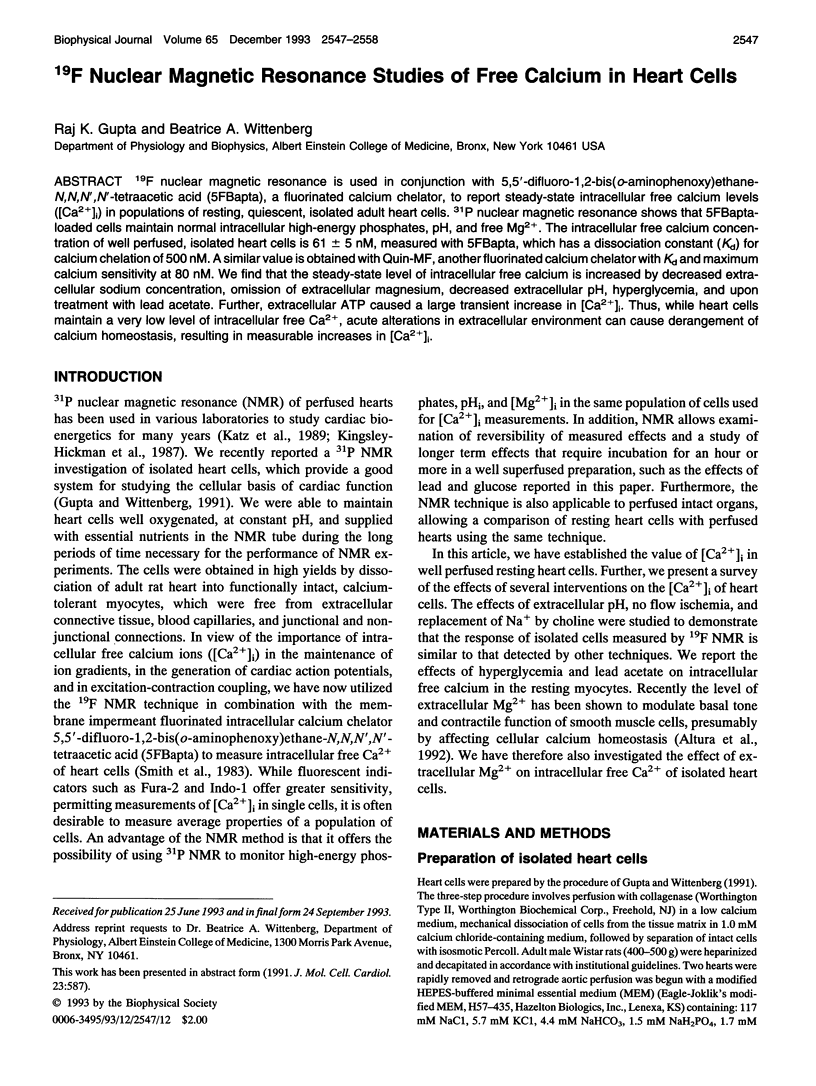
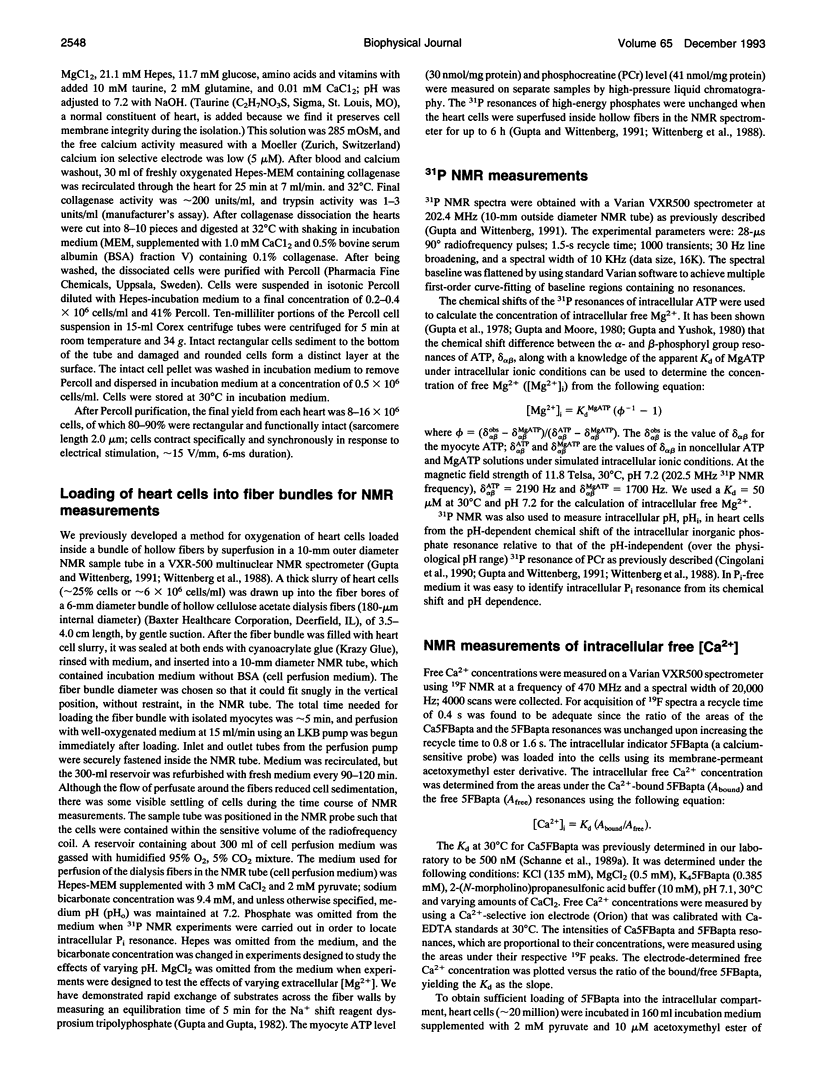
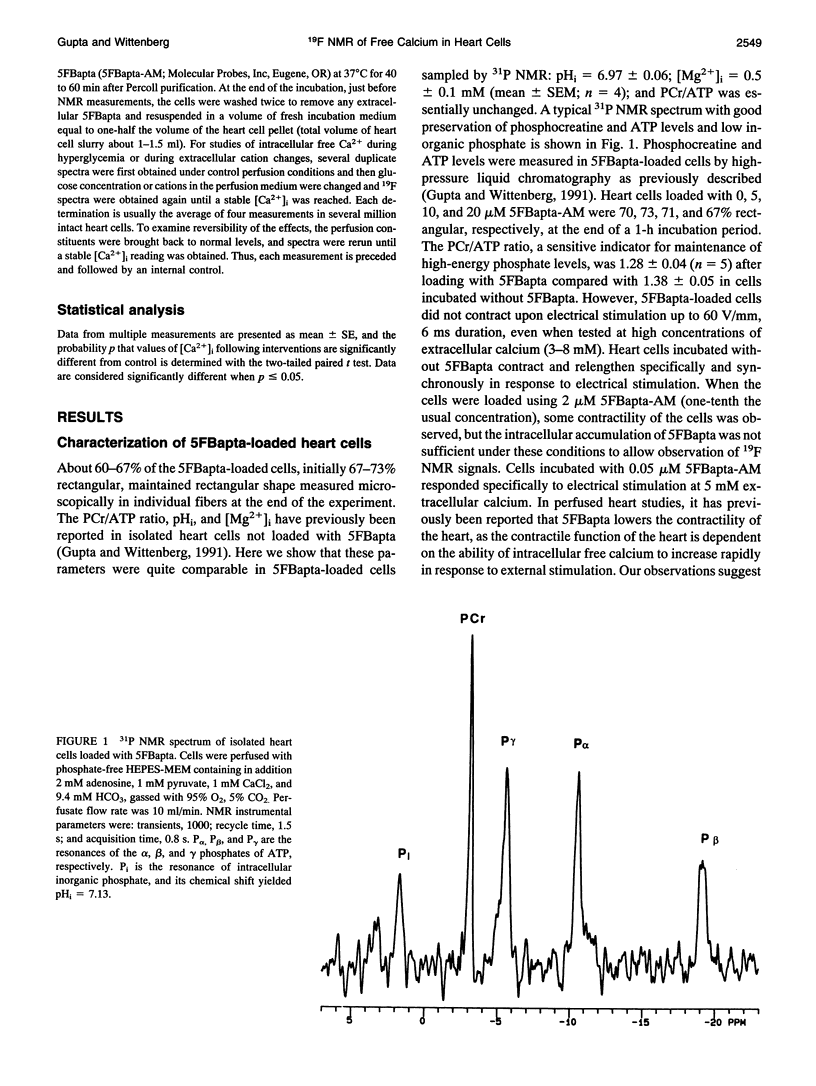
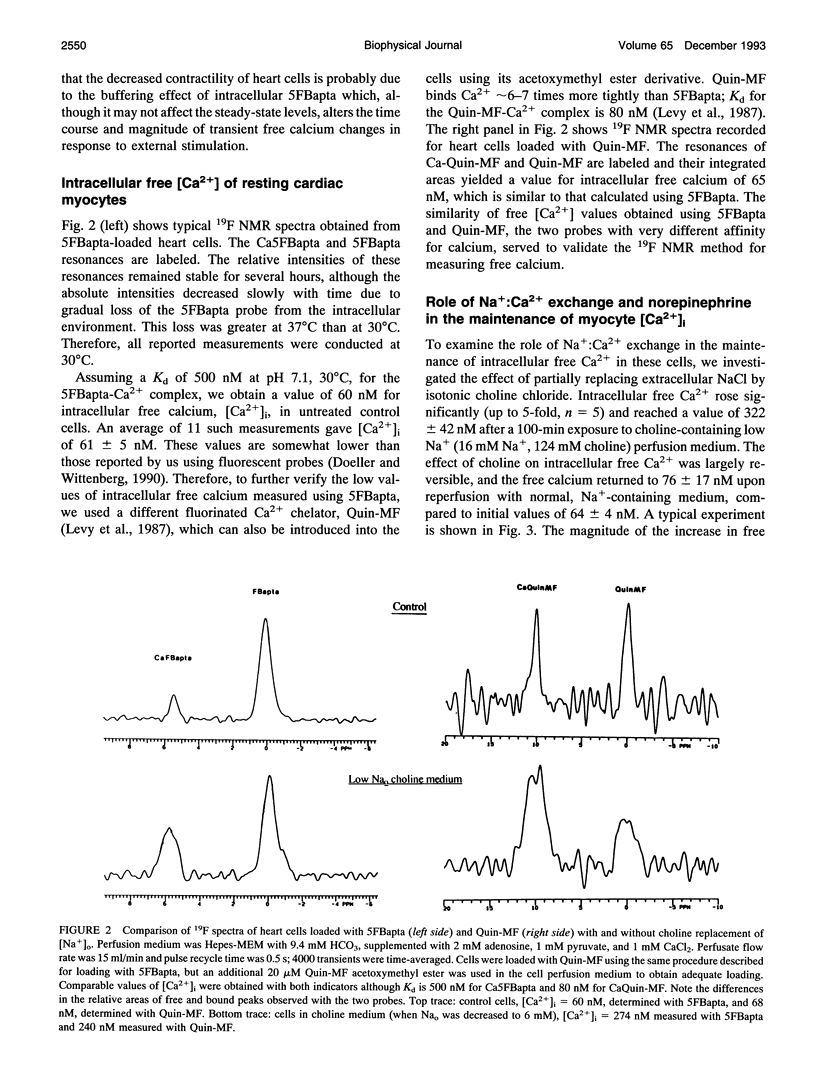
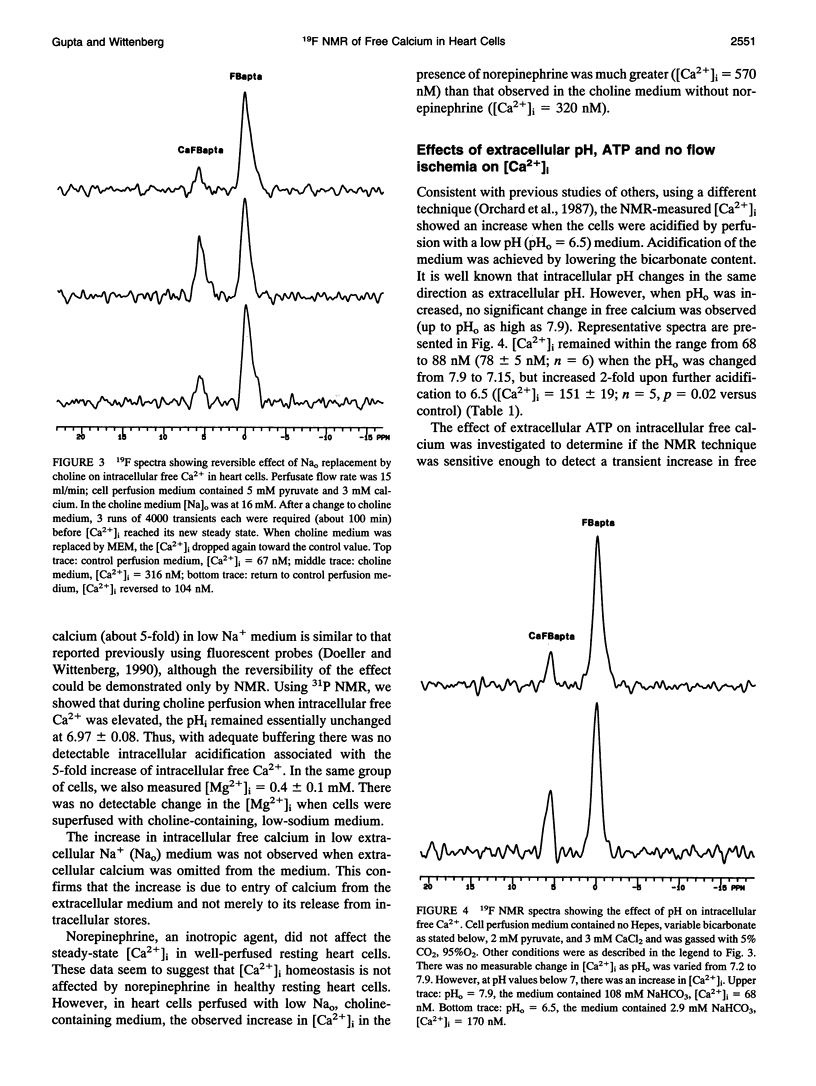
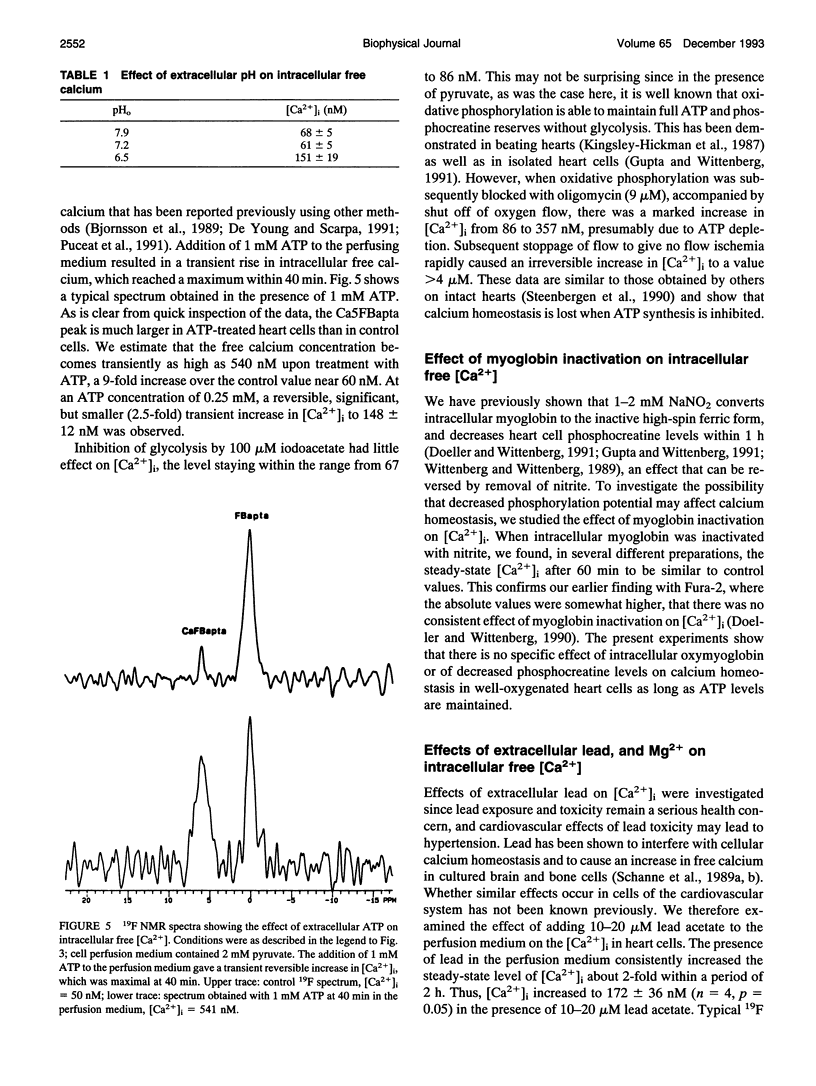
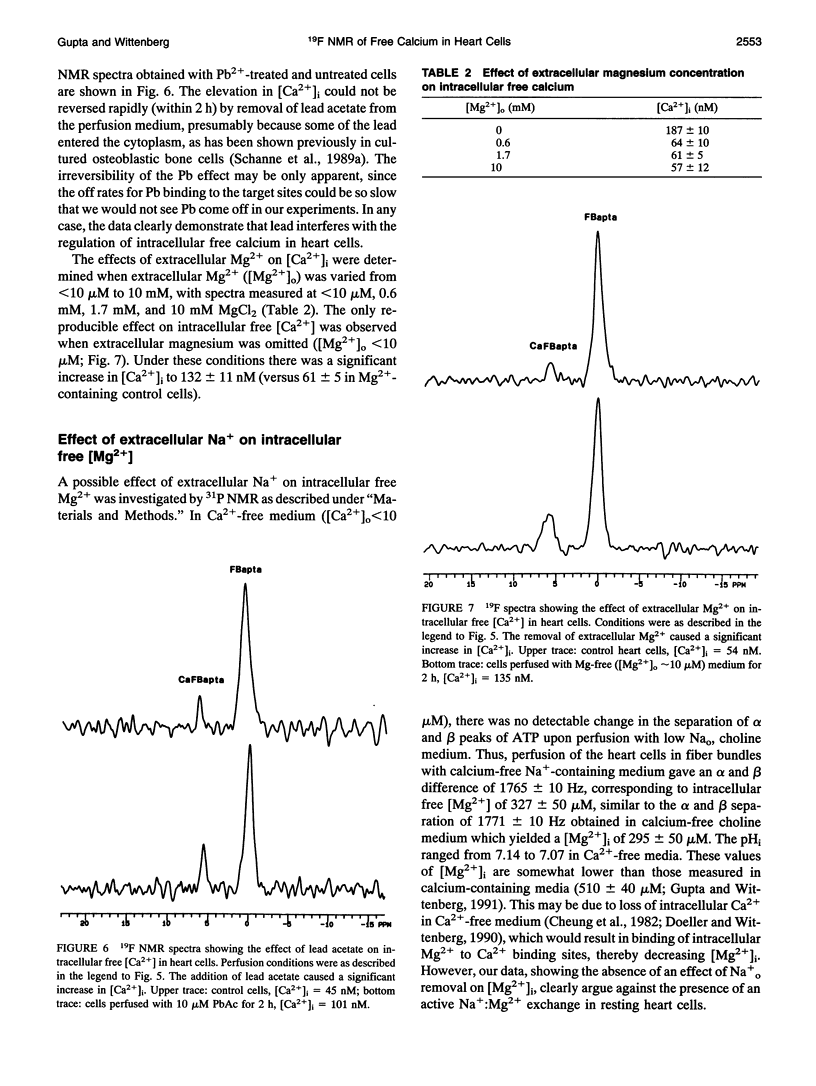
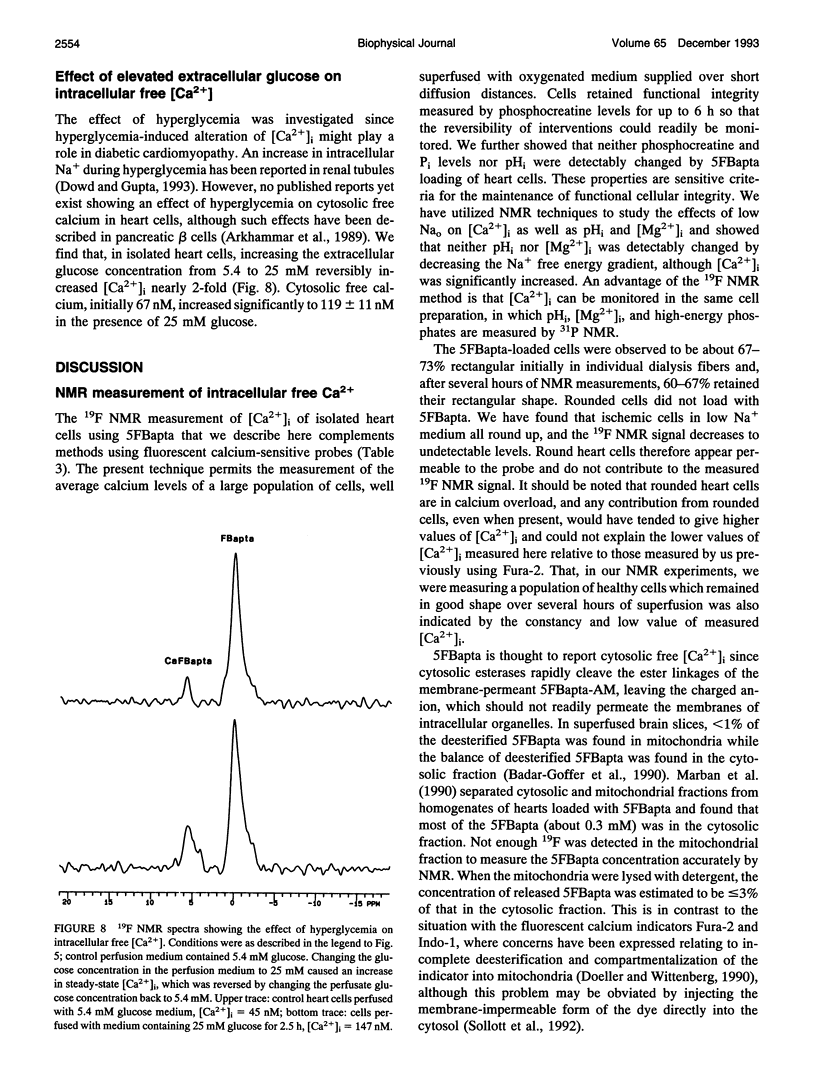
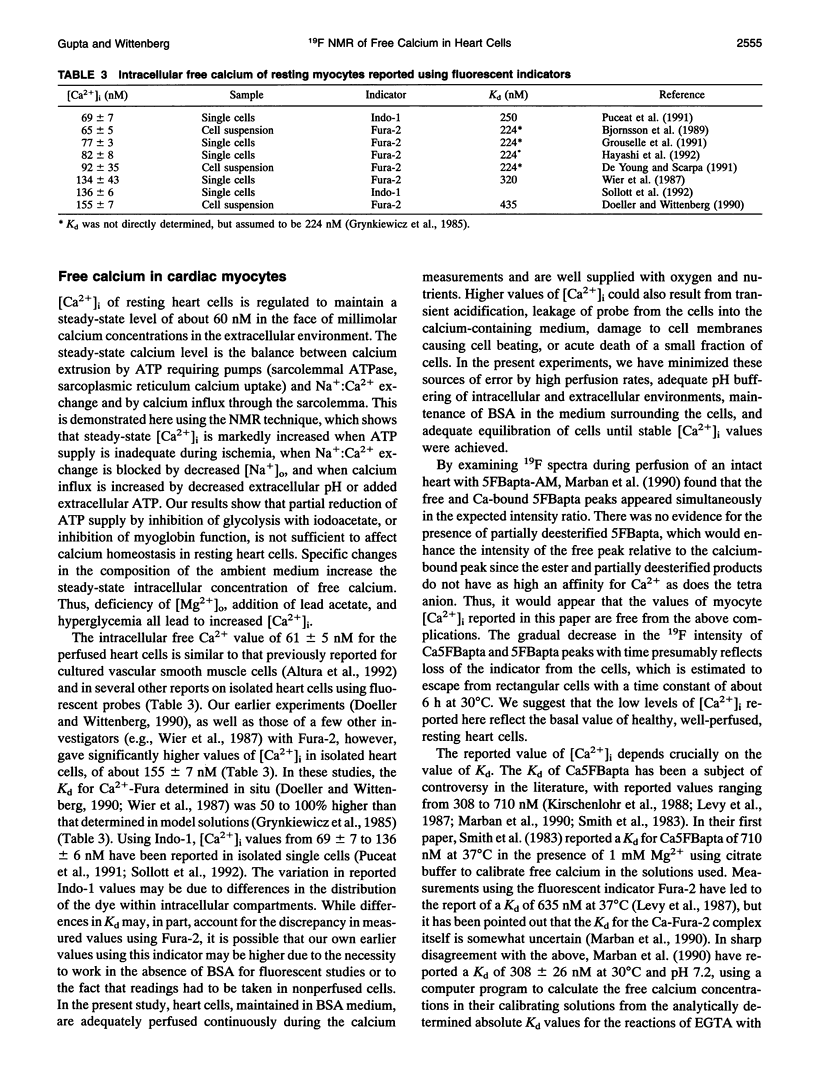
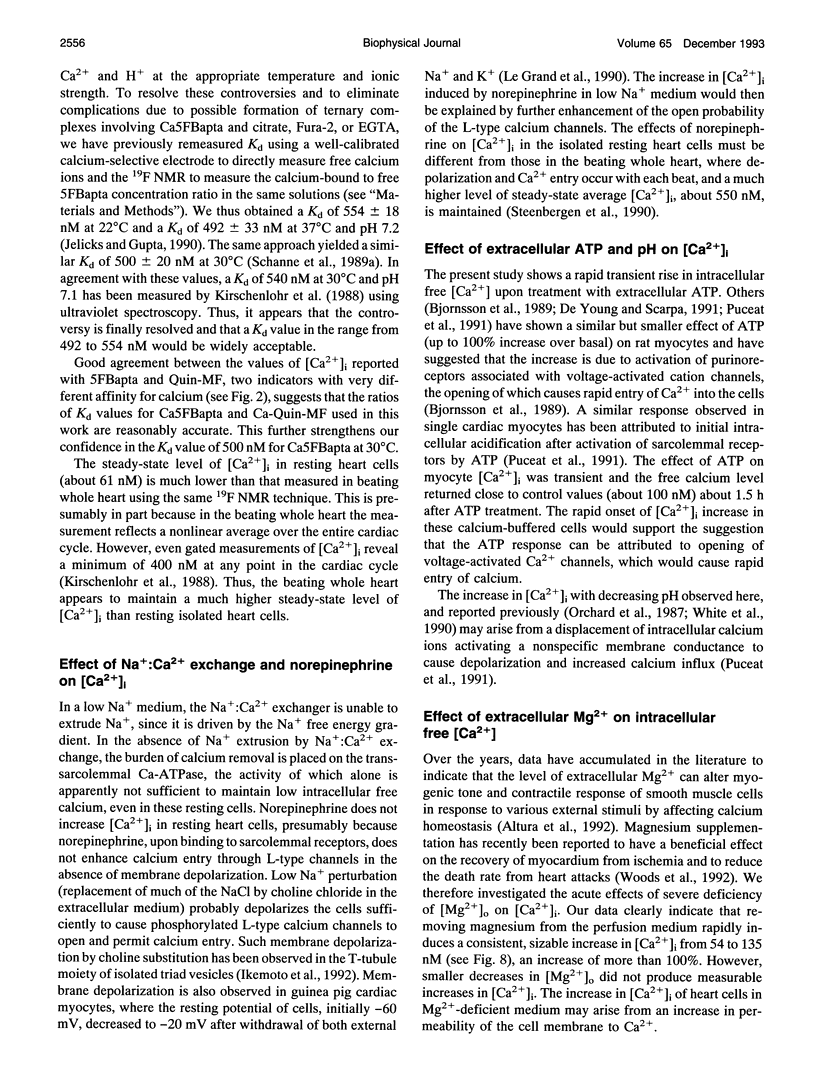
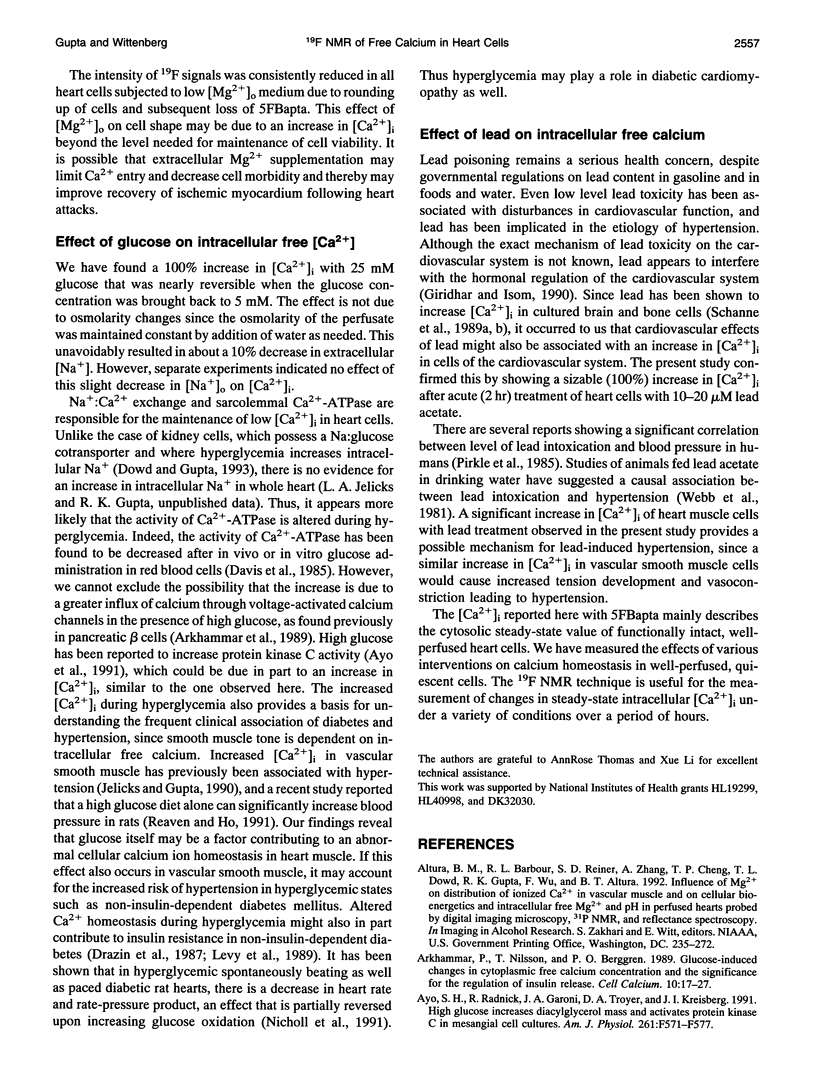
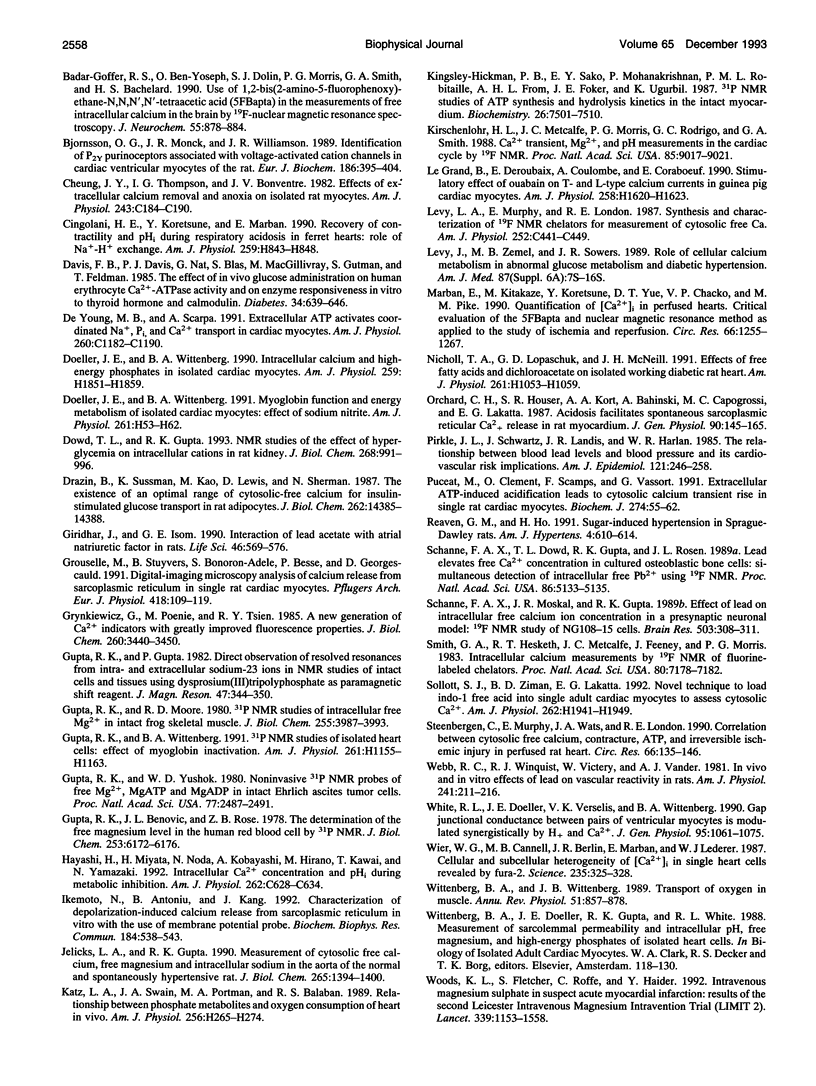
Selected References
These references are in PubMed. This may not be the complete list of references from this article.
- Arkhammar P., Nilsson T., Berggren P. O. Glucose-induced changes in cytoplasmic free Ca2+ concentration and the significance for the regulation of insulin release. Measurements with fura-2 in suspensions and single aggregates of mouse pancreatic beta-cells. Cell Calcium. 1989 Jan;10(1):17–27. doi: 10.1016/0143-4160(89)90040-7. [DOI] [PubMed] [Google Scholar]
- Ayo S. H., Radnik R., Garoni J. A., Troyer D. A., Kreisberg J. I. High glucose increases diacylglycerol mass and activates protein kinase C in mesangial cell cultures. Am J Physiol. 1991 Oct;261(4 Pt 2):F571–F577. doi: 10.1152/ajprenal.1991.261.4.F571. [DOI] [PubMed] [Google Scholar]
- Badar-Goffer R. S., Ben-Yoseph O., Dolin S. J., Morris P. G., Smith G. A., Bachelard H. S. Use of 1,2-bis(2-amino-5-fluorophenoxy)ethane-N,N,N',N'-tetraacetic acid (5FBAPTA) in the measurement of free intracellular calcium in the brain by 19F-nuclear magnetic resonance spectroscopy. J Neurochem. 1990 Sep;55(3):878–884. doi: 10.1111/j.1471-4159.1990.tb04573.x. [DOI] [PubMed] [Google Scholar]
- Björnsson O. G., Monck J. R., Williamson J. R. Identification of P2Y purinoceptors associated with voltage-activated cation channels in cardiac ventricular myocytes of the rat. Eur J Biochem. 1989 Dec 8;186(1-2):395–404. doi: 10.1111/j.1432-1033.1989.tb15222.x. [DOI] [PubMed] [Google Scholar]
- Cheung J. Y., Thompson I. G., Bonventre J. V. Effects of extracellular calcium removal and anoxia on isolated rat myocytes. Am J Physiol. 1982 Sep;243(3):C184–C190. doi: 10.1152/ajpcell.1982.243.3.C184. [DOI] [PubMed] [Google Scholar]
- Cingolani H. E., Koretsune Y., Marban E. Recovery of contractility and pHi during respiratory acidosis in ferret hearts: role of Na(+)-H+ exchange. Am J Physiol. 1990 Sep;259(3 Pt 2):H843–H848. doi: 10.1152/ajpheart.1990.259.3.H843. [DOI] [PubMed] [Google Scholar]
- Davis F. B., Davis P. J., Nat G., Blas S. D., MacGillivray M., Gutman S., Feldman M. J. The effect of in vivo glucose administration on human erythrocyte Ca2+-ATPase activity and on enzyme responsiveness in vitro to thyroid hormone and calmodulin. Diabetes. 1985 Jul;34(7):639–646. doi: 10.2337/diab.34.7.639. [DOI] [PubMed] [Google Scholar]
- De Young M. B., Scarpa A. Extracellular ATP activates coordinated Na+, Pi, and Ca2+ transport in cardiac myocytes. Am J Physiol. 1991 Jun;260(6 Pt 1):C1182–C1190. doi: 10.1152/ajpcell.1991.260.6.C1182. [DOI] [PubMed] [Google Scholar]
- Doeller J. E., Wittenberg B. A. Intracellular calcium and high-energy phosphates in isolated cardiac myocytes. Am J Physiol. 1990 Dec;259(6 Pt 2):H1851–H1859. doi: 10.1152/ajpheart.1990.259.6.H1851. [DOI] [PubMed] [Google Scholar]
- Doeller J. E., Wittenberg B. A. Myoglobin function and energy metabolism of isolated cardiac myocytes: effect of sodium nitrite. Am J Physiol. 1991 Jul;261(1 Pt 2):H53–H62. doi: 10.1152/ajpheart.1991.261.1.H53. [DOI] [PubMed] [Google Scholar]
- Dowd T. L., Gupta R. K. NMR studies of the effect of hyperglycemia on intracellular cations in rat kidney. J Biol Chem. 1993 Jan 15;268(2):991–996. [PubMed] [Google Scholar]
- Draznin B., Sussman K., Kao M., Lewis D., Sherman N. The existence of an optimal range of cytosolic free calcium for insulin-stimulated glucose transport in rat adipocytes. J Biol Chem. 1987 Oct 25;262(30):14385–14388. [PubMed] [Google Scholar]
- Giridhar J., Isom G. E. Interaction of lead acetate with atrial natriuretic factor in rats. Life Sci. 1990;46(8):569–576. doi: 10.1016/0024-3205(90)90124-a. [DOI] [PubMed] [Google Scholar]
- Grouselle M., Stuyvers B., Bonoron-Adele S., Besse P., Georgescauld D. Digital-imaging microscopy analysis of calcium release from sarcoplasmic reticulum in single rat cardiac myocytes. Pflugers Arch. 1991 Mar;418(1-2):109–119. doi: 10.1007/BF00370459. [DOI] [PubMed] [Google Scholar]
- Grynkiewicz G., Poenie M., Tsien R. Y. A new generation of Ca2+ indicators with greatly improved fluorescence properties. J Biol Chem. 1985 Mar 25;260(6):3440–3450. [PubMed] [Google Scholar]
- Gupta R. K., Benovic J. L., Rose Z. B. The determination of the free magnesium level in the human red blood cell by 31P NMR. J Biol Chem. 1978 Sep 10;253(17):6172–6176. [PubMed] [Google Scholar]
- Gupta R. K., Moore R. D. 31P NMR studies of intracellular free Mg2+ in intact frog skeletal muscle. J Biol Chem. 1980 May 10;255(9):3987–3993. [PubMed] [Google Scholar]
- Gupta R. K., Wittenberg B. A. 31P-NMR studies of isolated adult heart cells: effect of myoglobin inactivation. Am J Physiol. 1991 Oct;261(4 Pt 2):H1155–H1163. doi: 10.1152/ajpheart.1991.261.4.H1155. [DOI] [PubMed] [Google Scholar]
- Gupta R. K., Yushok W. D. Noninvasive 31P NMR probes of free Mg2+, MgATP, and MgADP in intact Ehrlich ascites tumor cells. Proc Natl Acad Sci U S A. 1980 May;77(5):2487–2491. doi: 10.1073/pnas.77.5.2487. [DOI] [PMC free article] [PubMed] [Google Scholar]
- Hayashi H., Miyata H., Noda N., Kobayashi A., Hirano M., Kawai T., Yamazaki N. Intracellular Ca2+ concentration and pHi during metabolic inhibition. Am J Physiol. 1992 Mar;262(3 Pt 1):C628–C634. doi: 10.1152/ajpcell.1992.262.3.C628. [DOI] [PubMed] [Google Scholar]
- Ikemoto N., Antoniu B., Kang J. J. Characterization of "depolarization"-induced calcium release from sarcoplasmic reticulum in vitro with the use of membrane potential probe. Biochem Biophys Res Commun. 1992 Apr 15;184(1):538–543. doi: 10.1016/0006-291x(92)91228-i. [DOI] [PubMed] [Google Scholar]
- Jelicks L. A., Gupta R. K. NMR measurement of cytosolic free calcium, free magnesium, and intracellular sodium in the aorta of the normal and spontaneously hypertensive rat. J Biol Chem. 1990 Jan 25;265(3):1394–1400. [PubMed] [Google Scholar]
- Katz L. A., Swain J. A., Portman M. A., Balaban R. S. Relation between phosphate metabolites and oxygen consumption of heart in vivo. Am J Physiol. 1989 Jan;256(1 Pt 2):H265–H274. doi: 10.1152/ajpheart.1989.256.1.H265. [DOI] [PubMed] [Google Scholar]
- Kingsley-Hickman P. B., Sako E. Y., Mohanakrishnan P., Robitaille P. M., From A. H., Foker J. E., Uğurbil K. 31P NMR studies of ATP synthesis and hydrolysis kinetics in the intact myocardium. Biochemistry. 1987 Nov 17;26(23):7501–7510. doi: 10.1021/bi00397a045. [DOI] [PubMed] [Google Scholar]
- Kirschenlohr H. L., Metcalfe J. C., Morris P. G., Rodrigo G. C., Smith G. A. Ca2+ transient, Mg2+, and pH measurements in the cardiac cycle by 19F NMR. Proc Natl Acad Sci U S A. 1988 Dec;85(23):9017–9021. doi: 10.1073/pnas.85.23.9017. [DOI] [PMC free article] [PubMed] [Google Scholar]
- Le Grand B., Deroubaix E., Coulombe A., Coraboeuf E. Stimulatory effect of ouabain on T- and L-type calcium currents in guinea pig cardiac myocytes. Am J Physiol. 1990 May;258(5 Pt 2):H1620–H1623. doi: 10.1152/ajpheart.1990.258.5.H1620. [DOI] [PubMed] [Google Scholar]
- Levy J., Zemel M. B., Sowers J. R. Role of cellular calcium metabolism in abnormal glucose metabolism and diabetic hypertension. Am J Med. 1989 Dec 8;87(6A):7S–16S. doi: 10.1016/0002-9343(89)90489-0. [DOI] [PubMed] [Google Scholar]
- Levy L. A., Murphy E., London R. E. Synthesis and characterization of 19F NMR chelators for measurement of cytosolic free Ca. Am J Physiol. 1987 Apr;252(4 Pt 1):C441–C449. doi: 10.1152/ajpcell.1987.252.4.C441. [DOI] [PubMed] [Google Scholar]
- Marban E., Kitakaze M., Koretsune Y., Yue D. T., Chacko V. P., Pike M. M. Quantification of [Ca2+]i in perfused hearts. Critical evaluation of the 5F-BAPTA and nuclear magnetic resonance method as applied to the study of ischemia and reperfusion. Circ Res. 1990 May;66(5):1255–1267. doi: 10.1161/01.res.66.5.1255. [DOI] [PubMed] [Google Scholar]
- Nicholl T. A., Lopaschuk G. D., McNeill J. H. Effects of free fatty acids and dichloroacetate on isolated working diabetic rat heart. Am J Physiol. 1991 Oct;261(4 Pt 2):H1053–H1059. doi: 10.1152/ajpheart.1991.261.4.H1053. [DOI] [PubMed] [Google Scholar]
- Orchard C. H., Houser S. R., Kort A. A., Bahinski A., Capogrossi M. C., Lakatta E. G. Acidosis facilitates spontaneous sarcoplasmic reticulum Ca2+ release in rat myocardium. J Gen Physiol. 1987 Jul;90(1):145–165. doi: 10.1085/jgp.90.1.145. [DOI] [PMC free article] [PubMed] [Google Scholar]
- Pirkle J. L., Schwartz J., Landis J. R., Harlan W. R. The relationship between blood lead levels and blood pressure and its cardiovascular risk implications. Am J Epidemiol. 1985 Feb;121(2):246–258. doi: 10.1093/oxfordjournals.aje.a113995. [DOI] [PubMed] [Google Scholar]
- Pucéat M., Clément O., Scamps F., Vassort G. Extracellular ATP-induced acidification leads to cytosolic calcium transient rise in single rat cardiac myocytes. Biochem J. 1991 Feb 15;274(Pt 1):55–62. doi: 10.1042/bj2740055. [DOI] [PMC free article] [PubMed] [Google Scholar]
- Reaven G. M., Ho H. Sugar-induced hypertension in Sprague-Dawley rats. Am J Hypertens. 1991 Jul;4(7 Pt 1):610–614. doi: 10.1093/ajh/4.7.610. [DOI] [PubMed] [Google Scholar]
- Schanne F. A., Dowd T. L., Gupta R. K., Rosen J. F. Lead increases free Ca2+ concentration in cultured osteoblastic bone cells: simultaneous detection of intracellular free Pb2+ by 19F NMR. Proc Natl Acad Sci U S A. 1989 Jul;86(13):5133–5135. doi: 10.1073/pnas.86.13.5133. [DOI] [PMC free article] [PubMed] [Google Scholar]
- Schanne F. A., Moskal J. R., Gupta R. K. Effect of lead on intracellular free calcium ion concentration in a presynaptic neuronal model: 19F-NMR study of NG108-15 cells. Brain Res. 1989 Dec 4;503(2):308–311. doi: 10.1016/0006-8993(89)91680-6. [DOI] [PubMed] [Google Scholar]
- Smith G. A., Hesketh R. T., Metcalfe J. C., Feeney J., Morris P. G. Intracellular calcium measurements by 19F NMR of fluorine-labeled chelators. Proc Natl Acad Sci U S A. 1983 Dec;80(23):7178–7182. doi: 10.1073/pnas.80.23.7178. [DOI] [PMC free article] [PubMed] [Google Scholar]
- Sollott S. J., Ziman B. D., Lakatta E. G. Novel technique to load indo-1 free acid into single adult cardiac myocytes to assess cytosolic Ca2+. Am J Physiol. 1992 Jun;262(6 Pt 2):H1941–H1949. doi: 10.1152/ajpheart.1992.262.6.H1941. [DOI] [PubMed] [Google Scholar]
- Steenbergen C., Murphy E., Watts J. A., London R. E. Correlation between cytosolic free calcium, contracture, ATP, and irreversible ischemic injury in perfused rat heart. Circ Res. 1990 Jan;66(1):135–146. doi: 10.1161/01.res.66.1.135. [DOI] [PubMed] [Google Scholar]
- White R. L., Doeller J. E., Verselis V. K., Wittenberg B. A. Gap junctional conductance between pairs of ventricular myocytes is modulated synergistically by H+ and Ca++. J Gen Physiol. 1990 Jun;95(6):1061–1075. doi: 10.1085/jgp.95.6.1061. [DOI] [PMC free article] [PubMed] [Google Scholar]
- Wier W. G., Cannell M. B., Berlin J. R., Marban E., Lederer W. J. Cellular and subcellular heterogeneity of [Ca2+]i in single heart cells revealed by fura-2. Science. 1987 Jan 16;235(4786):325–328. doi: 10.1126/science.3798114. [DOI] [PubMed] [Google Scholar]
- Wittenberg B. A., Wittenberg J. B. Transport of oxygen in muscle. Annu Rev Physiol. 1989;51:857–878. doi: 10.1146/annurev.ph.51.030189.004233. [DOI] [PubMed] [Google Scholar]
- Woods K. L., Fletcher S., Roffe C., Haider Y. Intravenous magnesium sulphate in suspected acute myocardial infarction: results of the second Leicester Intravenous Magnesium Intervention Trial (LIMIT-2) Lancet. 1992 Jun 27;339(8809):1553–1558. doi: 10.1016/0140-6736(92)91828-v. [DOI] [PubMed] [Google Scholar]


